|
MEDX Equipment
(available at the Kraus Back and Neck Institute)
APPLYING SCIENCE TO THE ART OF
MEDICINE
At the Kraus Back and Neck Institute (KBNI),
we believe in applying as much of a scientific approach as possible, to the
art of medicine. Back pain and neck pain has plagued modern civilization
for years, and ranks up there with the common flu, as the most likely cause
for a patient to see his/her physician. At the Kraus Back and Neck
Institute (KBNI), we believe that much back pain and neck pain can be
improved or eliminated, and many incidences of back and neck pain can be
prevented, by strengthening the muscles of the neck and low back. It is for
this reason, that we use the highly specialized MEDX Medical Lumbar and
Cervical Machines in our Institute. To the best of our knowledge, we are
the only facility in Houston, TX, which has these medical grade machines.
To gain a further understanding and
appreciation of what these machines can do, let us look at the history of
the machines, and at a history of body building and muscle building, in
general. Why is this important? Because if we understand how to build and
strengthen one muscle, we can strengthen other muscles. After all, a
muscle, is an muscle, is a muscle.
It was Arthur Jones who invented
Nautilus. Before Arthur Jones, the single greatest invention in the area of
body building, was the barbell and dumbbell. Now, consider a simple
exercise, such as a dumbbell curl, which is intended to work and strengthen
the biceps. When you really watch someone performing this exercise, you can
see that the first 30 degrees of flexion are mainly a horizontal movement,
not causing the raising of the weight against gravity. Yet the biceps
muscle is contracting. The next 30-40 degrees of motion are mainly
vertical, and the biceps muscle is working to lift the weight against
gravity. The last 30 degrees of motion, is again, mainly a horizontal
movement, with the biceps muscle contracting, but not doing much work
against gravity. In summary, we can see that roughly 60 percent of the
movement of the bicep curl is not against gravity, and although the biceps
muscle is contracting, it is not being strained during this part of the
biceps curl. The 30-40 degrees of motion which are against gravity (30-40
percent of the full range of motion), are the only portion of the curl,
where real work and strain is being exerted by the bicep muscle.
How is muscle built and strengthened?
There is a common belief that going to the gym and straining the muscle,
makes it stronger. This is not true. Weight lifting actually causes damage
to muscle, and results in micro tears of the muscle fibers. It is when
these damaged muscle fibers heal, that the muscle grows stronger.
Therefore, when 60 percent of the range of motion of a bicep curl is not
causing muscle strain, much of this activity is wasted. True, a bicep curl
will produce results, but not the best results one could expect, if they
provided resistance to flexion during the entire range of motion of the
muscle. In the words of a well known professional football coach I recently
spoke with, he said that for his players, "I don't just want results, I want
the best results they can get."
Arthur Jones realized the shortcomings of
exercises such as the dumbbell curl, and realized that if one could give the
bicep muscle a resistance during the entire range of motion of the muscle,
then one could achieve better results as far as strengthening of the
muscle. Arthur Jones realized that if the resistance was provided not by
lifting a weight, but by rotating a cam, that this effect could be
accomplished. That is what prompted him to invent Nautilus. Nautilus was
the first of these types of machines to be invented, and subsequently, a
number of other companies began to develop similar types of machines.
In general, a rotary type of resistance
allows one to isolate a muscle group, whereas a linear movement will recruit
different muscle groups. We have already looked at the rotary movement to
strengthen the biceps muscle. Another example would be the pec deck, which
is used to strengthen the pectoral muscles. In this exercise, the athlete
or patient is sitting on a bench, with a backrest, and with the arms held
out perpendicularly to the upper torso, with the elbows either flexed or
straight, he/she compresses two bars or pads together, effectively providing
a rotary motion about the shoulders, and isolating the pectoral muscles.
On the other hand, a linear motion
incorporates more than one muscle group. Let's take the bench press. In
this exercise, the athlete or patient is lying on a bench. He or she has a
barbell straddled across the chest (with weights on either end of the
barbell), and, while gripping the bar with the elbows held at a 90 degree
angle, pushes the barbell up into the air, until the elbows are straight.
The barbell is then lowered, and the process repeated. The muscle groups
involved in this linear motion are the pectoralis, as well as the triceps
and the anterior deltoids.
One might think that this is an efficient
way to train, and in fact, many body builders have traditionally liked these
free weight, linear, types of motions. Much of this stems from the early
days of bodybuilding. Many bodybuilders will also claim that the lifting of
free weights also strengthens the "stabilizer muscles," which are those
other muscles which are needed to support the shoulder girdle, etc.
However, let us look at the shortcomings of this method of training. When
using the linear movement, let's say that the anterior deltoid muscle is the
weakest muscle (compared to the pectoral and tricep muscles). Then, during
a bench press, the anterior deltoid muscle will tire first, and the athlete
or patient will cease being able to lift the barbell, before the triceps or
pectoral muscles are worked and fatigued. Thus, the anterior deltoid muscle
may receive a good workout, but the tricep and pectoral muscles will not be
worked. On the other hand, an exercise to provide rotary resistance to the
anterior deltoid, pectoral, and tricep muscles, individually, will allow the
individual to work each of these muscles to fatigue.
Thus, Nautilus, which was developed and
invented by Arthur Jones, was one of the greatest inventions in the world of
muscle training.
Arthur Jones also proposed another novel
concept, in the 1970's, which has subsequently been shown to have objective
scientific data to support it. We will present this research and data
further on in this discourse. Traditionally, body builders will lift
weights for a certain number of repetitions per set, and perform three sets
of that exercise. For example, one might perform a bicep curl of thirty
pounds, eight times, and perform this set of exercises three times. Arthur
Jones felt that this was counterproductive, and that in fact, one only
needed to perform the exercise, with 12-15 repetitions, but to perform it to
complete volitional muscular fatigue. What that means, is that one should
do this particular exercise until one cannot possibly perform that exercise
any more, and the muscle is completely fatigued. Then, one is done with
that exercise. No more exercise of that muscle group is needed. He felt
that if one could repeat exercise with another repetition, then they didn't
work hard enough the first time, because if they did, they wouldn't be able
to complete the exercise again. Not only shouldn't one repeat the exercise,
but Arthur Jones felt that repeating the exercise will lead to overtraining,
and more breakdown of muscle, than building of muscle.
Arthur Jones believed that those body
builders who spent 20 hours a week in the gym, would gain more muscle mass,
if they reduced their workouts to possibly 5 hours a week in the gym. While
it is true that the person who lifts too frequently will gain muscle, he/she
may very well gain more muscle if they lift less frequently. This
contradicts what one would consider to be common sense. For example, if
someone is working both arms to build and strengthen the biceps muscle, what
will one do if their right bicep muscle is smaller than their left bicep.
The action most people would take, is to lift more frequently with the right
arm, while the correct action to build the right bicep muscle may actually
be to lift less frequently with the right bicep, and allow the muscle to
heal between lifting sessions, and gain rest and nutrition to grow. Again,
any type of exercise, even when done incorrectly, will produce results, but
our goal, is to produce, the best results possible, for that individual.
These early speculations of Arthur Jones,
on the ideal way to train muscles for strengthening, were subsequently
validated, when machines which allowed the accurate measurement of muscular
stgrength, were developed. These Medical Grade MedX Lumbar and Cervical
Machines are used at the Kraus Back and Neck Institute (KBNI), and allow us
to objectively measure and evaluate muscle strength in the neck and low
back, at varying degrees of flexion and extension.
Medical Machines
After successfully developing and running
the Nautilus company, Arthur Jones started a company called MedX. He
contributed significant money and time into researching the best ways to
isolate and strengthen the lumbar and cervical spine. The machines which
MedX produces, for this purpose, are the standard of the industry. The
medical grade varieties of this equipment are not commonly found, but they
allow the isolation, evaluation, and strengthening of the lumbar and
cervical spines. Because these machines allow us to accurately and
precisely measure the strength of the lumbar and cervical spines, at various
degrees of flexion and extension, we can add a scientific basis to the
strengthening of the spine, and can tell exactly how well out techniques of
spine strengthening actually work.
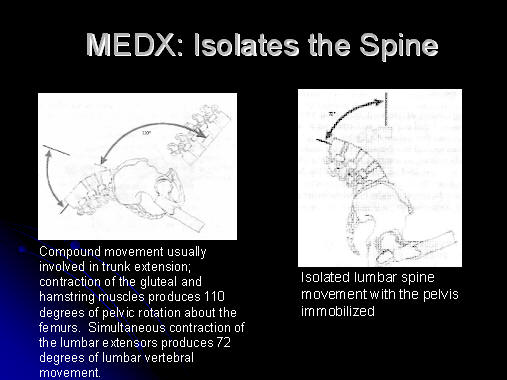
Most exercises which are intended to
strengthen the lower back, actually strengthen the gluteal and hamstring
muscles, and have much less effect upon strengthening the muscles of the
lumbar spine. Resistance training using progressive degrees of resistance
is effective in building muscle strength, but those muscles which we are
intending to strengthen must be worked through their range of motion. The
traditional exercises which are thought to strengthen the lumbar spine,
include hyperextensions on the roman chair, dead lifts, and extension chairs
found at most gyms. If you actually observe someone performing these
exercises, one can observe that they are actually holding their lumbar
spines in a locked, fixed position, and the gluteal and hamstring muscles
are really doing most all of the work.
To better understand this, let's look at
an exercise to strengthen the arm. If we perform heavy bicep curls, the
biceps will get stronger, significantly out of proportion to any gain in
strength of the muscles of the forearm. Why is this? Because in a curl,
the arm flexes at the elbow, causing the bicep muscle to contract and
lengthen during flexion and extension, respectively. But since the wrist is
locked in an isometric position, the muscles of the forearm, which control
wrist flexion and extension, are stationary, and not put through a strain
associated with flexion and extension. The bicep curl exercise will
strengthen the biceps, but not the wrist.
Similarly, traditional back strengthening
exercises will strengthen the gluteal and hamstring muscles, which flex and
extend during this exercise, but will not strengthen the lumbar muscles.
For that, we need a machine which will lock the knees and pelvis into
position, and allow only flexion and extension of the lumbar spine. MedX
for the lumbar and cervical body parts, is such a machine.
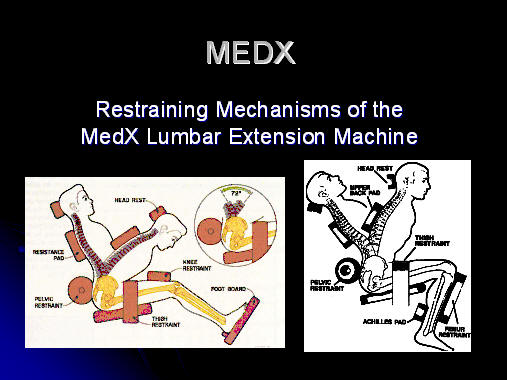
As can be seen from the images shown
above, the MedX Lumbar Medical Machine allows one to isolate the lumbar
spine, and exclude any efforts of the hamstring and gluteal muscles.
This is accomplished through the use of knee restraints, thigh restraints,
and pelvic restraints.

Again, the restraints which allow the lumbar spine to be
isolated, are shown.
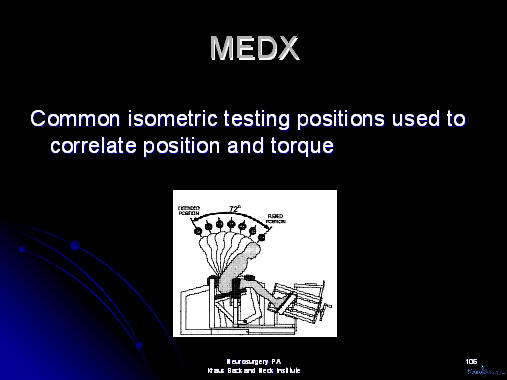
Using an isometric testing approach, since the MedX
Lumbar Medical machine isolates the lumbar spine, it can be used to
accurately and precisely measure the strength of the lumbar spine. The
same principle is used for the cervical spine, using the MedX Cervical
Medical machine. This can be used to evaluate strength and Range of
Motion, and to evaluate improvements in strength and range of motion.
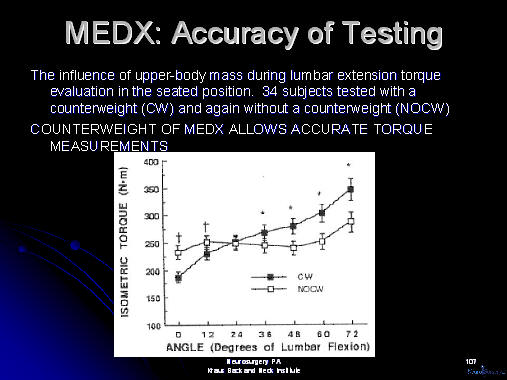
The MedX Medical Lumbar and Cervical machines also take
into account the weight of the body itself, through the use of
counterweights. For example, if one is bent over at the hips, and
pushes back in an extensor type of motion, some of this effort will be used
to simply lift the upper torso against gravity. If one were sitting
upright, instead of being bent over, this weight of the torso would not be
present against an extensor type of force. The counterweights present
on the MedX Medical machines allow the accurate measurement of strength, and
take the body weight out of the equation, thus allowing a very accurate
measurement.
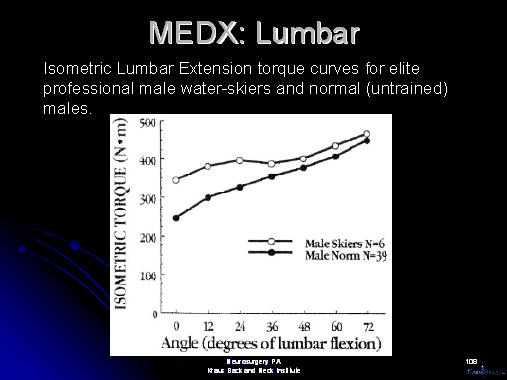
Above, we see that, as expected, male waterskiers have
greater lumbar spine strength, than normal, untrained males. The x
axis represents the degrees of flexion of the lumbar spine. 0 degrees
of flexion is sitting upright, while 72 degrees of flexion means the subject
is bent over at the hips.
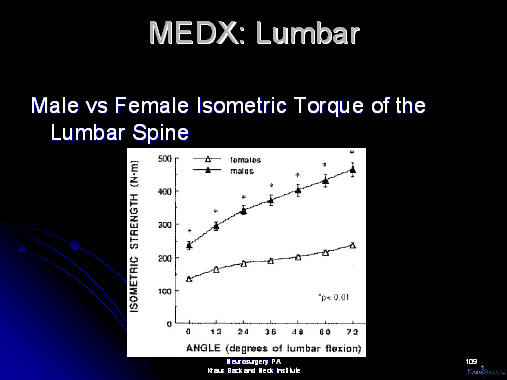
Again, as expected, males have a stronger spine, than do
females.
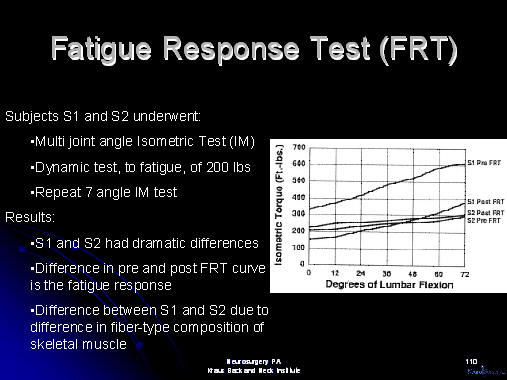
The fatigue response test (FRT) indicates how much
deterioration in strength there is, after a subject performs a repetitive
exercise to fatigue the back. An isometric test is done to evaluate
strength, then the subject is taken through a series of exercises to cause
muscle fatigue, then the isometric test is repeated, to evaluate the
strength.
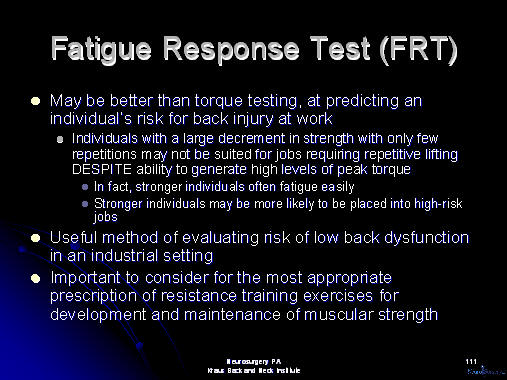
The fatigue response test may be beneficial in helping to
determine which individuals may be at risk for injury on the job.
Those who fatigue early on, and to a significant degree, may also weaken
after repetitive strenuous tasks in the workplace. In this case,
prevention of injury may involve strengthening of the lumbar spine, before a
back injury occurs, in order to prevent it from occurring.
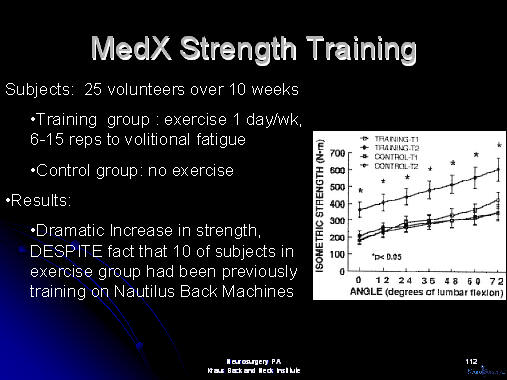

It is of great interest, and somewhat surprising, that
the increases in strength which occurred with training once every two weeks,
were as significant as those which occurred with training three times per
week, provided that the exercises in the once per two week group, were done
to complete muscular fatigue. The implications of these results, on
the training of the rest of the body, may be significant.
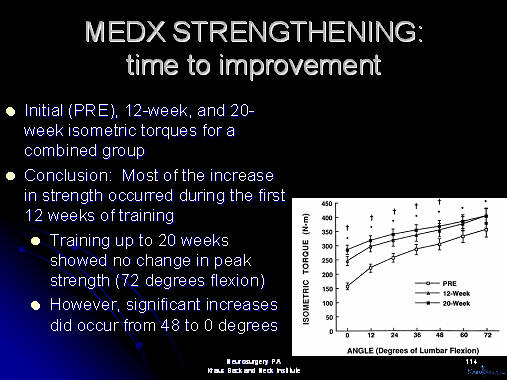
Most of the increases in strength occur within the first
12 weeks of training.

One set of exercises, done to voluntary muscular failure,
is all that is needed to strengthen the muscles. Additional sets of
exercises are unnecessary.
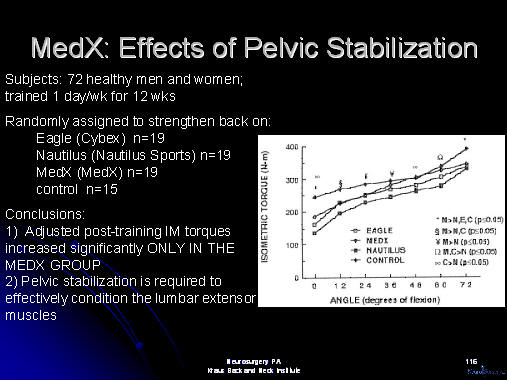
The study above examined the effects of MedX, versus
Eagle (Cybex), Nautilus and controls, in strengthening the lumbar spine.
Accoring to the study, MedX was the only machine which effectively and
consistent ly provided for the strengthening of the lumbar spine.
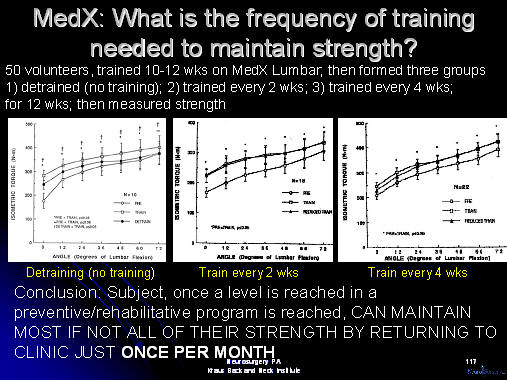
Another remarkable finding is that after the desired
strength of the spine is achieved, doing the strengthening exercises just
one per month, is all that is needed to maintain the muscular strength.
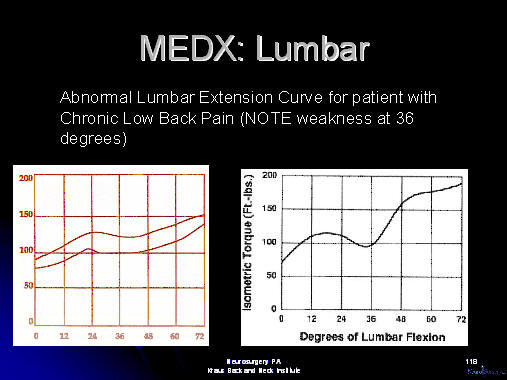
In an injured patient, or one with low back pain, the
nice linear curve may not be seen, but instead, there may be a dip in the
curve, indicating an area of weakness in the lumbar spine.
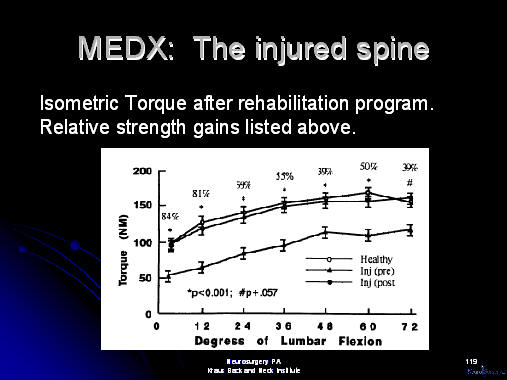
Above, we see that after the injured patient has
undergone strengthening using the MedX Lumbar Medical Machine, there is a
significant improvement in lumbar strength.
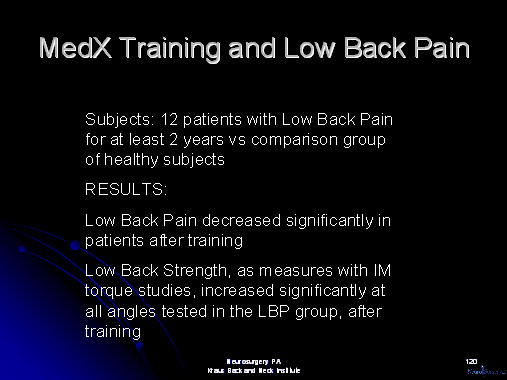
In the above study, low back pain was observed to
decrease significantly in patients who had undergone back strengthening.
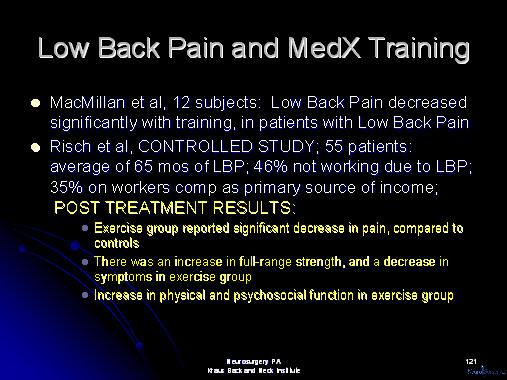
The above study by MacMillan showed that an exercise
group (which had an increase in strengthreported significant decrease in
pain, compared to controls.
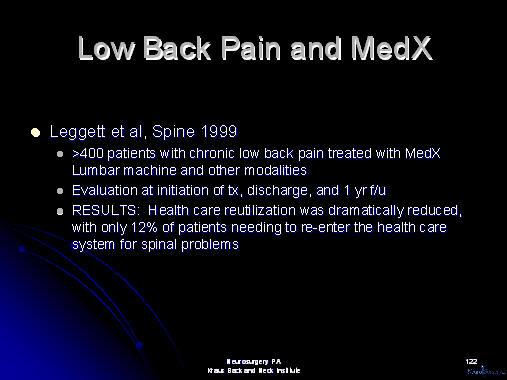
Leggett et al (Spine) showed that when over 400 patients with chronic
low back pain were treated with MedX, only 12% of these patients needed to
re-enter the health care system due to spinal problems.
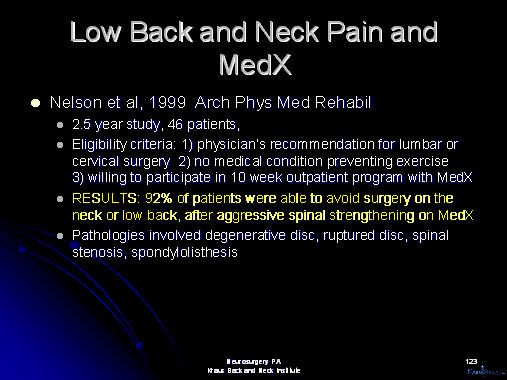
In the study by Nelson et al (Arch Phys Med Rehabil) , 92% of patients who were already
recommended for surgical intervention, were able to avoid surgery on the
neck or low back, after agressive spinal strengthening on MedX.
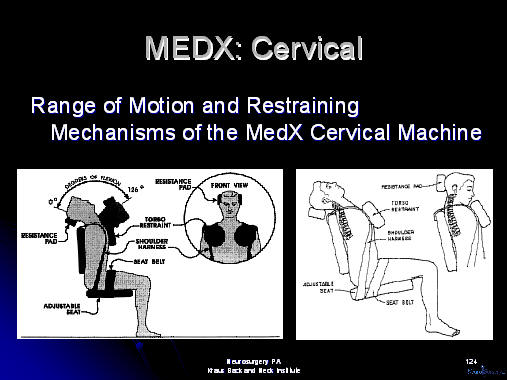
The MedX Cervical Medical Machine follows the same
principle as the Lmbar Machine. By immobilizing the chest, the neck
can be isolated, evaluated and strengthened.
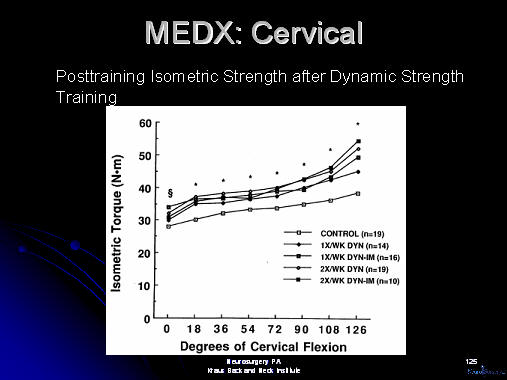
As with the lumbar machine, the cervical machine need
only be utilized once per week, with the subjects exerting themselves to
maximal volitional fatigue.

In order to maintain strength, training once per week
provides most of the benefits of training twice per week.

The above study Highland et al (Spine) showed that in a
group of 90 patients who experienced neck pain, strengthening of the neck
resulted in a decrease in neck pain.
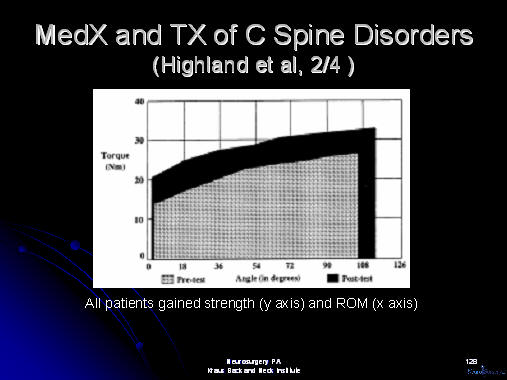
Training on the MedX cervical medical machine not only
increased strength of the neck (cervical spine), but it also increased the
range of motion.
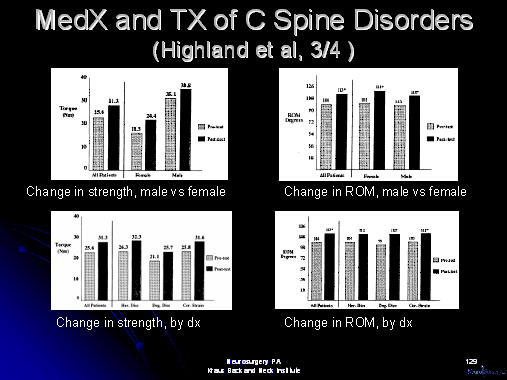
This increase in strength and range of motion held true,
in both males and females, and by different diagnoses.
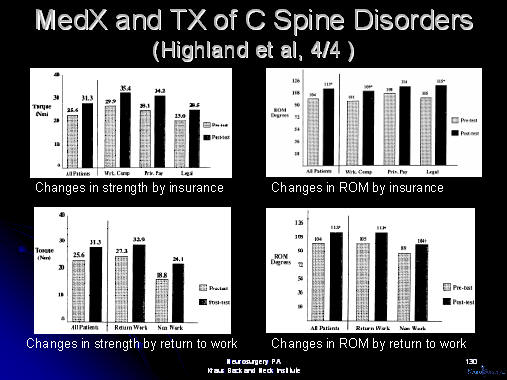
This increase in strength and increase in range of
motion, in patients who underwent strengthening on the cervical medx
machine, held true in patients, regardless of insurance type, and regardless
of return to work dates.
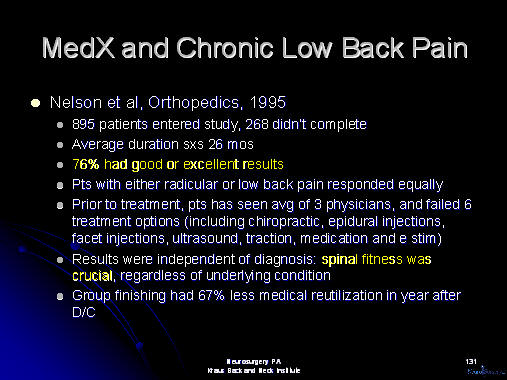
The above study by Nelson et al (Orthopedics)
demonstrated, in 895 patients, that many patients with chronic low back pain
experienced improvement after strengthening their lumbar spines with MedX
Lumbar medical equipment. It is interesting, that prior to this MedX
LOumbar Medical strengthening, these patients had seen an average of 3
physicians, and failed 6 treatment options (including chiropractic, epidural
steroid injections, facet injections, ultrasound, traction, medication and
electrical stimulation).
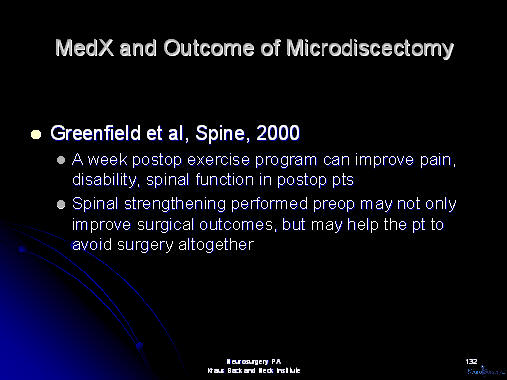
The above study by Greenfield et al (Spine) , showed that
postoperative exercise may improve surgical outcomes. In addition,
spinal strengthening may help the patient to avoid surgery altogether.
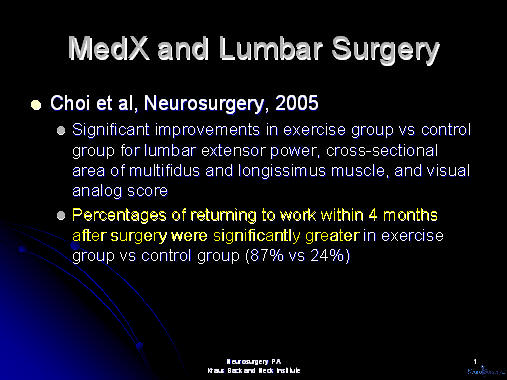
In the above study, Choi et al ( Neurosurgery) showed
that the percentages of patients returning to work, within 4 months after
surgery, were significantly greater in the exercise group than in a
non-exercise (control) group.
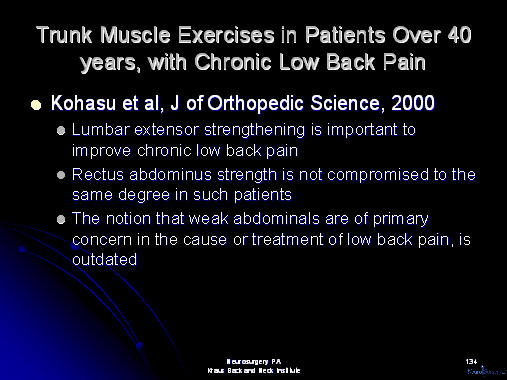
In the past, it was often thought that weak abdominal
muscles are of primary concern in the cause or treatment of low back pain.
Kohasu et al (J of Orthopedic Science), have shown in the above study, that
lumbar extensor muscle strengthening is important in improving chronic low
back pain. Abdominal strength is not compromised to the same
degree in such patients.
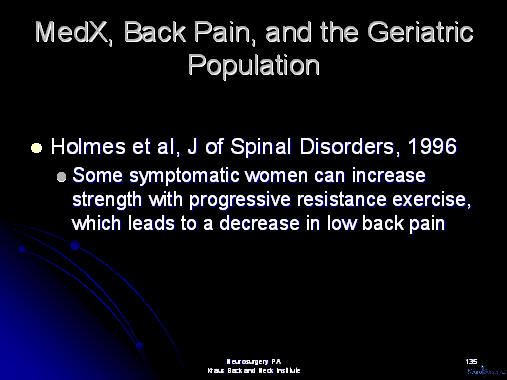
Holmes et al ( J of Spinal Disorders) have shown that
women with symptomatic low back pain, can increase strength with progressive
resistance exercise, leading to a decrease in low back pain.

Low back pain is one of the most significant causes of
days lost on the job. Each year, there are a tremendous number of
workers compensation claims filed because of low back pain. Mooney et
al (J of Occupational Rehab), in the above study, found that patients with
low back pain experienced an increase in strength of their low backs, of 54%
to 104%, during a 20 week program. The average workers' compensation
liability dropped from $14,430 per month, to $380 per month, for the study
year. They also found, that a significant increase in low back
strength correlated with greatly reduced incidence of back injury claims.
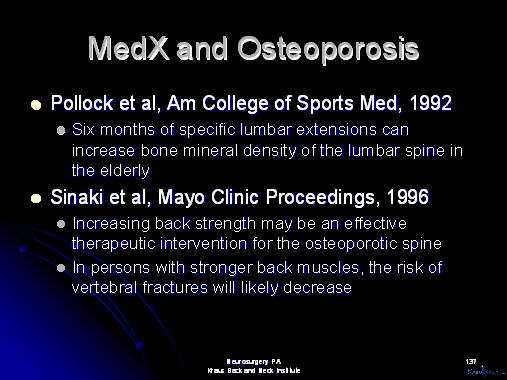
Wolff's law states that when bone is placed under stress,
in grows and becomes stronger. This principle is known to surgeons who
operate on bones. For example, as a neurosurgeon, when I place a graft
of bone between two vertebral bodies, I rely on the stress placed upon the
graft, by the compression of the two vertebral bodies, to help the bone
graft to grow, and be incorporated into the fusion of one vertebral body to
the adjacent one. This pressure is needed to keep bones strong.
It is interesting to note, that the astronauts, after having been in the
weightless environment of space, experience a loss of bone density after
they return to earth.
Similarly, Pollack et al (Am College of Sprots Med) , and
Sinaki et al (Mayo Clinic Proceedings) , have shown in the above studies,
that strengthening the lumbar spine also results in strengthening of the
bone, decreasing the likelihood of osteoporotic compression fractures.
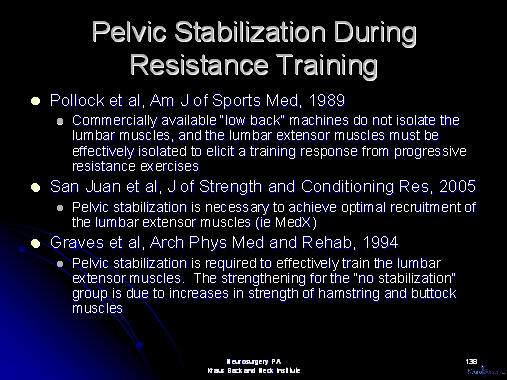
Earlier in this discussion, we reviewed the advantages of
the MedX Lumbar and Cervical Medical machines, in strengthening the lumbar
and cervical spines. We pointed out the fact that these lumbar and cervical
medical MedX machines serve to isolate the lumbar and cervical spines, but
immobilizing other supporting parts of the body, thus eliminating them from
the equation when it comes to strengthening.
Above, Pollock et al (Am J of Sports Med), San Juan et al
(J of Strength and Conditioning Res), and Graves et al (Arch Phys Med
and Rehab) have shown this to be true. They show that pelvic
stabilization is necessary to strengthen the lumbar spine.
Furthermore, the "strengthening" which is apparently seen in a group which
trains without pelvic stabilization, is due in large part to increases in
strength of the hamstring and buttock muscles, and not due to the lumbar
spine muscles.
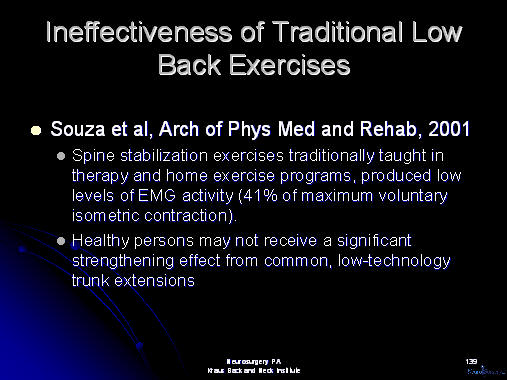
Many patients are given home exercises. While these
may help to some degree, and are better than doing nothing, Souza et al
(Arch of Phys Med and Rehab) have shown that healthy persons may not receive
a significant strengthening effect from common, low technoloty trunk
extensions. Souza showed this based on EMG (electromyographic )
activity of muscles tested during different home exercise programs.
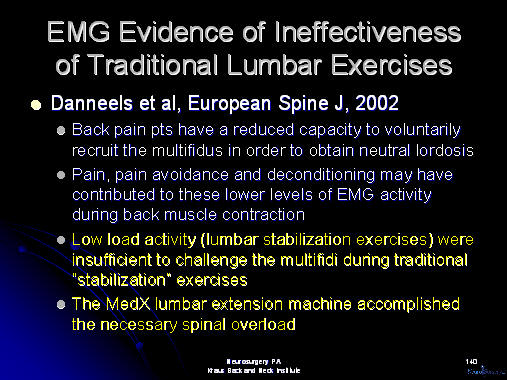
Danneels et al (European Spine J) concluded, as well,
that low load activity (traditional lumbar stabilization exercises) were
insufficient to challenge the multifidi (lumbar spine muscles) during
"traditional" lumbar stabilization exercises. Danneels found that the
MedX lumbar medical extension machine accomplished the necessary spinal
overload needed to strengthen the muscle.
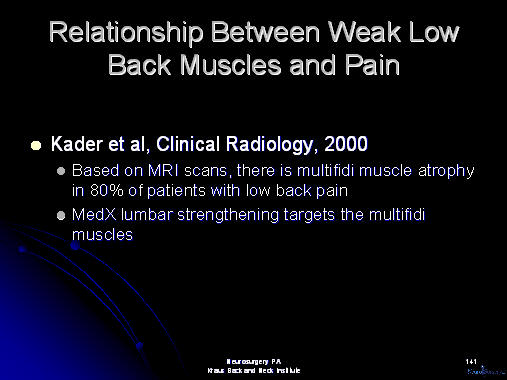
Kader et al (Clinical Radiology) found that in 80% of
patients with low back pain, MRI (magnetic resonance imaging studies)
demonstrate atrophy or shrinkage of the multifidi muscles (lumbar spine
muscles). They found that MedX lumbar strengthening targets the
multifidi muscles.
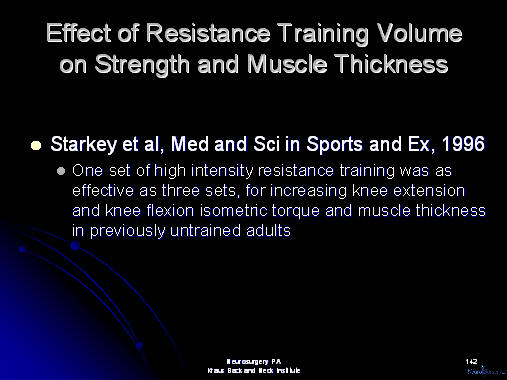
Confirming some of the above graphs, Starkey et al (Med
and Sci in Sports and Ex) found that one set of high intensity resistance
training was as effective as three sets, for increasing knee extension and
knee flexion isometric torque and muscle thickness in previously untrained
adults.

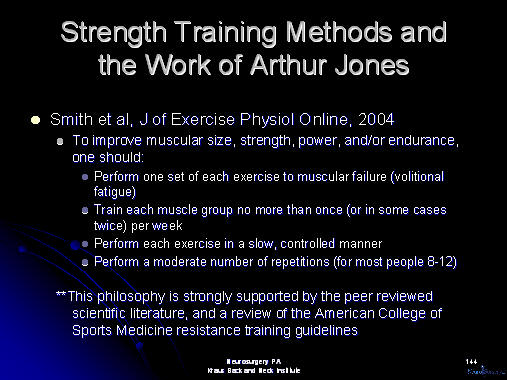
Once again, as reviewed by Smith et al (J of Exercise
Physiol Online), the strength training principles of Arthur Jones are
strongly supported by the peer reviewed scientific literature, and a review
of the American College of Sports Medicine resistance training guidelines.
These principles state
To improve muscular size, strength, power, and/or
endurance, one should
perform one set of exercise to muscular failure
(volitional fatigue)
train each muscle group no more than once (or in some
cases twice) per week
perform each exercise in a slow, controlled manner
perform a moderate number of repetitions (for most people
8-12)
|

